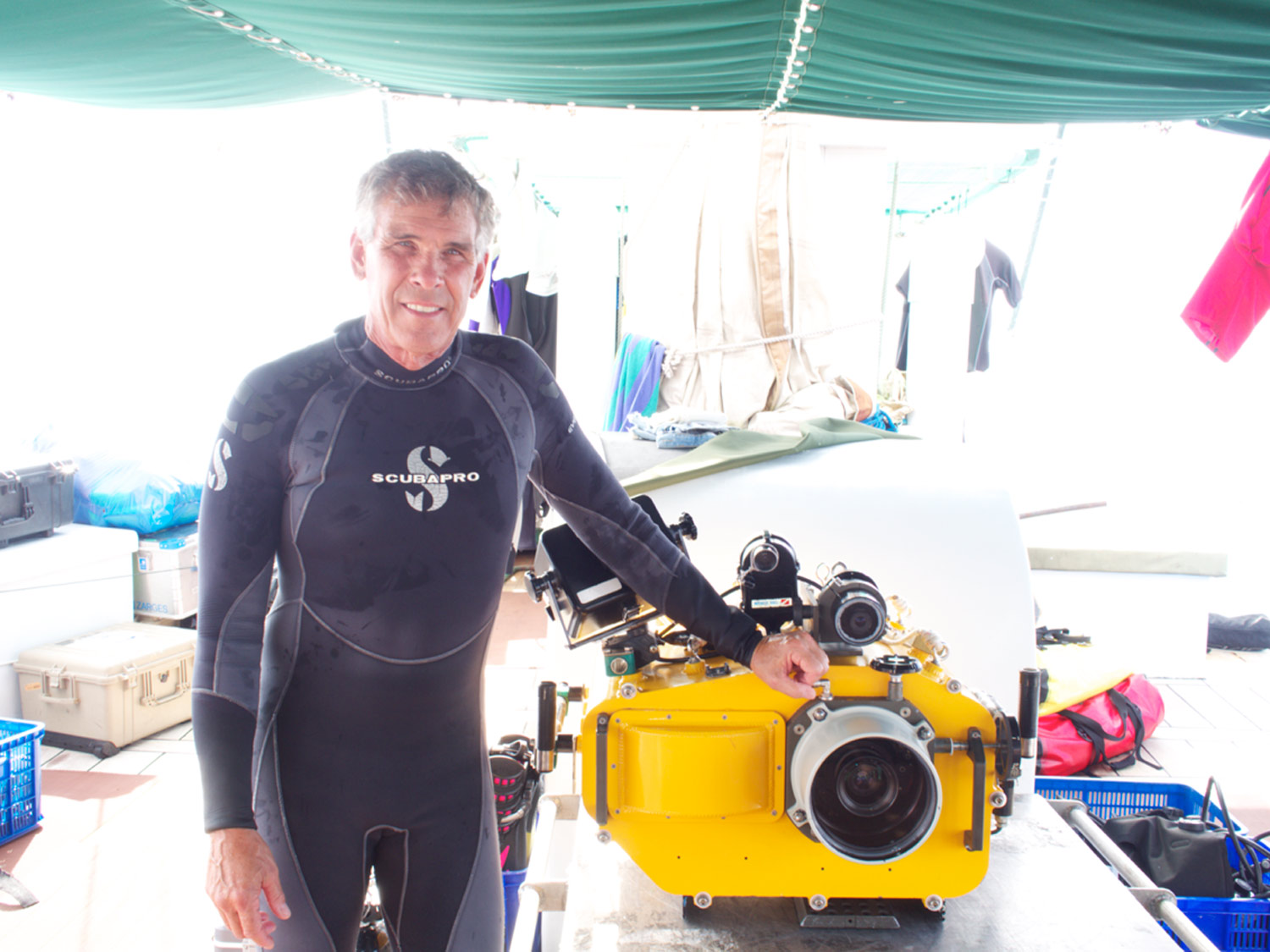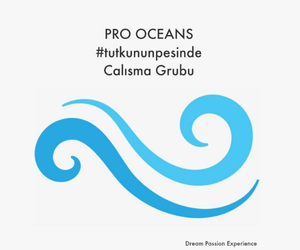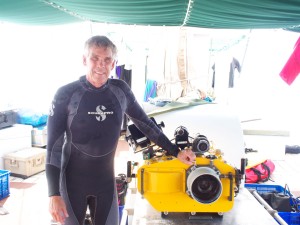Howard Hall with the Pig, a camera that can shoot IMAX films under the sea.
IMAX technology, which is more than forty years old, owes its amazing longevity to its visual quality. Experts estimate that its effective resolution is in the range of a digital camera with eight thousand to eleven thousand horizontal pixels, according to Hall, which is better than what you would find on HDTV sets sold today, and, for those of us with untrained eyes, is on par with higher-end professional digital video cameras.
Diving alongside Hall, I watched as he guided the rig away from the surface, where tiny islands of jagged, jungle-covered limestone dotted the horizon. Forty feet below, he found himself atop an underwater hill that dive guides in the area had nicknamed Grouper. He could see a forest of hard and soft coral, and schools of fish swimming in every direction, backlit by sunlight. Hall was looking for mobula rays—the mobula is a relative of the manta ray—feeding on a school of anchovies. A team of support divers, encumbered with lights and power cables, hovered around him while he remained near the top of the seamount. After a few moments, he turned in to the current and focussed his camera on a blue void.
A minute later, thousands of color-flecked anchovies swarmed him head on, like a pulsing, glimmering fog. Hall leaned back slowly, cued the lights, smoothly aimed the yellow box upward at the school, and turned on the camera, which sounded like a muffled lawnmower. After three minutes, all the film was spent. Everything had gone perfectly, but no mobulas had shown up to devour the anchovies. When Hall returned to the expedition’s mother ship, the Pindito, I asked him how he knew which direction the anchovies would come from. “A lot of it is intuition,” he said. “Insight develops over long time and experience.”
Over the next few days, Hall continued to look for mobulas, but shots were hampered by rough weather, empty dive sites, and bad luck. One great shot was lost because the camera was set up for a wide-angle lens better suited for landscapes when a fish swam right up in front of the camera. Another was foiled because the lens was fitted with the wrong filter. “When the opportunity swims by, you either get lucky that you have the right gear or, more often, let it go and try to shoot it again another time,” Hall told me. Sometimes the size and the din of the IMAX camera, or other unintended noise, scare the fish away. During the recording of one sequence, mobulas were feeding on anchovies when a light bulb randomly imploded, causing glass to rain down in front of the lens. The noise and the light caused the anchovies to break formation, and the mobulas went into a frenzy, devouring hordes of the rattled fish, but Hall had already turned off the camera, so he missed the shot. It’s disappointing when things go wrong, he said. “But, when things fail, I get a chance to enjoy the environment and look around.”
Hall got into underwater photography while getting a degree in zoology at San Diego State University. He told me, half joking, but with a full smile, that he started working with animals after doing underwater stunts—“the people were assholes.” His break came in 1976, when, on a foggy morning off the coast of California, he snapped a rare shot of a gray whale in a kelp bed. After it was published in National Geographic, he was hired as a shark adviser for the film “The Deep,” and earned a hundred dollars a day spearfishing bait to lure apex predators. He used the money to build a waterproof 16-mm. camera with an electric motor that extended the filming time from the typical fifteen seconds per spring-loaded windup to twelve minutes. This advanced camera allowed him to stay down longer between film swaps and to get better shots, which led to his landing a job shooting for “The American Sportsman,” on ABC, and, eventually, “Mutual of Omaha’s Wild Kingdom.”
In 1990, after a decade of producing and filming other people’s work, Hall released his own début, “Seasons in the Sea,” which depicted coastal California sea life as no one else had captured it—blue whales and sharks feeding on krill, giant jellyfish, shark eggs hatching, the mating of bat rays, and basking sharks feeding on plankton. It won Best in Show at the Wildscreen wildlife-film festival. That led to Hall’s collaborations with National Geographic, the IMAX Corporation, and the filmmaker Greg MacGillivray.
MacGillivray hired Hall to shoot the underwater scenes in his most recent film, “Journey to the South Pacific,” a documentary about the wildlife of the Raja Ampat Islands, an Indonesian archipelago whose waters may contain more species than any other similarly sized place in the world, according to researchers from the nonprofit Conservation International. MacGillivray, who has shot more than two million feet of IMAX footage during his five-decade career, told me that Hall is better than anyone else in the field. His underwater shots, which make up sixty to seventy per cent of “Journey,” took most of the production’s effort, time, and money. The film, narrated by Cate Blanchett, was released to a wide audience earlier this year.
Besides being on a boat for weeks, one way for underwater cameramen to acquire more and better footage is simply to shoot for as long as possible. Hall’s team dove several hours a day for about a month, using seventy-one rolls—about eight hundred and fifty-two pounds—of IMAX film to produce the roughly twenty minutes of footage that appeared onscreen. To increase his time underwater per dive, Hall dives with an apparatus called a rebreather, which uses special filters to remove carbon dioxide from his exhalations so that the air can be piped back into his mouthpiece. His breathing gear was originally designed, in the nineteen-eighties, as a prototype for U.S. Special Forces. He has modified it so that he can stay down for up to twelve hours, if necessary—far longer than is possible with normal scuba gear, which is limited to about an hour and change at shallow depths. The rebreather is also less disturbing to wildlife, since, unlike traditional scuba gear, it doesn’t vent bubbles. After one of his dives, Hall opened a dog-eared notebook and logged his twenty-five-hundredth hour in a rebreather maintenance log; regular maintenance is critical, because rebreathers are more complicated than scuba life-support systems. When they fail, they often kill.
During one of the final dives of the trip, I asked MacGillivray if he was going to join us. He told me that filming nature documentaries on location is in part about mitigating risks by avoiding dangerous situations if possible—which is why he usually does not allow outsiders to observe production in the wild. After all, he said, if something were to happen, “it could end the expedition.”
Dropping into the water with my scuba gear, I was immediately deposited into a coral garden with terraced steps. It descended into a low valley with a strong current that whipped past an overhang. Hall, manning the IMAX rig, spotted a lionfish and waved divers who were carrying a lighting rig into action. Another diver brought a tripod and planted it in a sandy spot on the bottom. Then they did nothing for fifteen minutes while they waited for the fish to get into the correct position to film. Between the waiting and the energy I exerted staying in place, my air gauge ran lower than it had on any other dive of the trip. The rest of the divers, on rebreathers, had no such worries.
As soon as the shot was finished, I made for the surface. A strong current sent me toward a piece of coral that looked like a golden cauliflower, but the current chucked me around it before impact. My gauge indicated that I still had some air left, but then my tank ran dry. I held my breath and tapped a nearby support diver on the shoulder, giving him the hand signal for running out of air: the motion of slitting my throat. He passed me his spare regulator and held his shoulder strap so that the currents couldn’t separate us. After a few minutes, we broke the surface. The shot of the lionfish never made it to the final film.
We got back to the Pindito, but before we had a chance to get out of our wetsuits a returning team of scout divers informed us that they had spotted anchovies not far away. We changed tanks and headed off to a nearby island, large and long, with a heavy limestone overhang above a reef, which quickly dropped off to much deeper waters. Fifty feet below, the lights came on, and I could hear the rumble of the IMAX camera. A school of anchovies swam by, followed by nine mobulas, mouths agape.
Brian Lam lives in Hawaii.
Photographs by Brian Lam.





